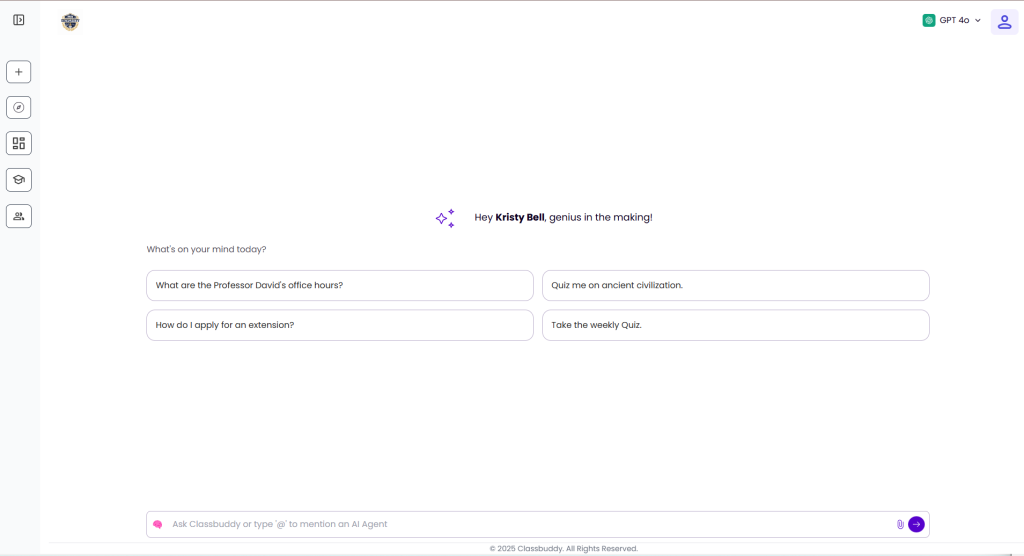
Smart, Scalable, Secure: Custom AI Agents for Universities Explained
Discover how custom AI agents for universities streamline HR, teaching,



Home » Top 5 Benefits of Using an AI Teaching Assistant for Teachers

AI is changing every industry, from finance to healthcare to education. And whether we like it or not, it’s not going away. In fact, it’s quickly becoming a core part of how students learn and institutions operate. Students are already using AI tools to brainstorm essays, create study plans, and even draft emails and essays. But this doesn’t have to be a student-only revolution. The right AI Teaching Assistant for Teachers can transform how teachers and professors teach, support, and engage with their students too.
Instead of banning AI or playing catch-up, educators have the opportunity to lead. That leadership begins with exploring how AI teaching assistants that are designed specifically for higher education can support faculty in meaningful, measurable ways.
According to the 2025 EDUCAUSE Students and Technology Report, students commonly use AI to:
Tools like ChatGPT, Grammarly, and custom LMS bots are becoming second nature for students. But faculty are lagging.
In the same report, 68% of respondents said students use AI significantly more than faculty. And yet, when used right, an AI Teaching Assistant for Teachers can make a significant difference in workload, course design and even help to increase classroom engagement.
It’s time to reframe AI, not as a threat, but as a tool. An AI powered teaching assistant in USA classrooms can shift the dynamic in favor of professors, giving them time back and offering students real-time support.
Here are the top 5 benefits of using AI Teaching Assistant for Teachers in Universities
Let’s start with something every professor and teacher can relate to:
“Where’s the assignment rubric?”
“What are your office hours again?”
“How do I request an extension?”
Even if these answers are posted in the LMS and mentioned repeatedly in class, students still ask the same questions, especially during busy or stressful times in the semester.
That’s where an AI Teaching Assistant for teachers makes a big difference. These AI assistants can automatically respond to common questions using the syllabus, announcements, or course rules uploaded into the system.
With tools like Classbuddy, teachers and professors can also choose FAQs as prompts so the students know they can ask these questions from the AI teaching assistant.

It’s not just about convenience, though that is a big benefit, it’s about helping students get the information they need faster, while also reducing the back-and-forth with emails and keeping communication clear. For many schools and universities, adopting an AI teaching assistant in USA classrooms is the first step toward a more scalable, sustainable way to support both teachers and students.
With common student questions managed by an AI Teaching Assistant for teachers, educators can shift their focus to more impactful aspects of instruction. Time previously spent replying to repetitive emails can now be redirected toward curriculum enhancement and individualized student support.
This means teachers and professors can spend more time:
Platforms like Classbuddy, MagicSchool and TeachMate are already helping teachers and professors nationwide streamline their weekly workload with smart automations and instructional content generation.
Once AI has taken over routine communications and foundational tasks, faculty gain visibility into patterns that would otherwise go unnoticed. Many AI Teaching Assistant for teachers platforms include dashboards that analyze student engagement and behavior across the semester.
These tools surface:
This isn’t just data – it’s actionable insight. With this knowledge, teachers and professors can intervene earlier, clarify confusing topics, or adjust pacing based on real student needs.
What makes this even more powerful is that many AI teaching assistants in USA also support content adjustment. Once a knowledge gap is identified, the instructor can use the AI assistant to generate supporting materials, such as follow-up explanations, focused quiz questions, or supplementary study resources.
As noted by Harvard’s Usable Knowledge, AI doesn’t just support students—it helps faculty make better decisions about teaching.
This visibility is one of the key reasons why more schools and universities are adopting AI teaching tools in the USA; they help teachers and professors adjust their approach and improve how students learn within days, not semesters.
Another major benefit of an AI Teaching Assistant for teachers is around-the-clock availability.
Students often study late at night, and that’s when their questions hit hardest. Rather than waiting hours (or days) for a response, they can ask the AI teaching assistant and get instant support.
What’s more, solutions like Classbuddy work directly inside LMS platforms like Canvas and Blackboard. That means students can get help where they’re already doing the work – no extra accounts, no friction.
This level of access creates a better learning experience while still protecting academic integrity. And in AI powered teaching assistants in USA classrooms, it’s a huge boost towards students’ self-guided learning.
Grading is essential, but it’s also one of the biggest time sinks for teachers and professors. With AI tools like CoGrader and Classbuddy, instructors can upload a rubric and have AI assist in the evaluation process.
While human judgment is still required (especially for nuanced assignments), AI can:
In addition to grading, these tools can also help to create content. An AI Teaching Assistant for teachers can create:
While some might worry that these tools will replace humans altogether, human judgment and guidance are still needed when it comes to creating the grading framework and subsequently grading itself, especially for creative and subjective courses. However, what the AI teaching assistant does is significantly reduce the time it takes to grade hundreds of assignments. This gives back time to teachers and professors so they can focus on providing quality feedback as opposed to the quantity of grading.
According to the National Council on Teacher Quality (NCTQ), AI tools like these can enhance teaching effectiveness and reduce burnout, especially in high-volume, high-stakes grading environments.
It’s just one more way that AI powered teaching assistants in USA are supporting faculty at scale.
Here’s the reality: banning AI won’t stop students from using it. The only way forward is to teach with it and teach how to use it well.
According to the 2025 EDUCAUSE AI Landscape Study, 63% of institutions now prioritize faculty training in AI tools. That means that while universities and schools understand the need, the teachers and professors need to take the next step.
Organizations like AI for Teachers and the AI Pedagogy Project are helping bridge this gap with accessible courses, certifications, and community resources.
The more proficient teachers and professors become in AI, the more effectively they can model responsible use for their students and prepare them for the future workforce. That’s the goal of every AI powered teaching assistant in USA classrooms: to support both teacher development and student success.
As UNESCO highlights, AI in education is not just about efficiency, it’s about equity, innovation, and access.
With the right AI Teaching Assistant for teachers, teachers and professors can claim back their time, enhance student experience, and teach more effectively. From grading support and real-time insights to automating repetitive questions, AI acts as a quiet but powerful teaching partner.
Looking ahead, teachers and professors face a choice: either watch the transformation unfold – or lead it.
The future of higher education is closely linked to the adoption of AI-driven tools. The educators who embrace these technologies today will be the ones shaping what teaching looks like in the years to come.
Sources:
Author:
Pakeezah Hashmi

Discover how custom AI agents for universities streamline HR, teaching,

In today’s fast-paced higher education environment, university professors across America

Artificial Intelligence is no longer a distant frontier in higher
